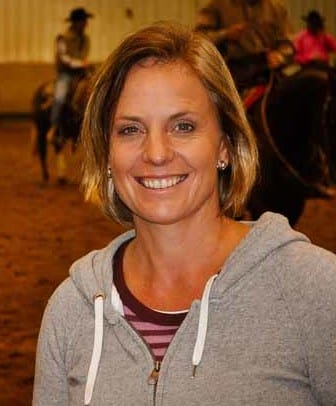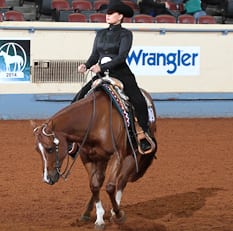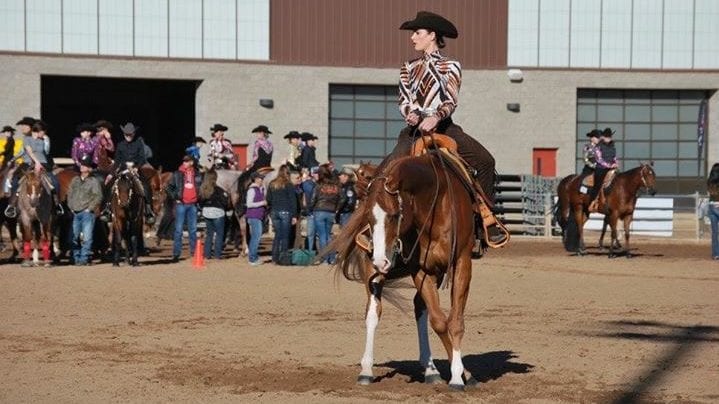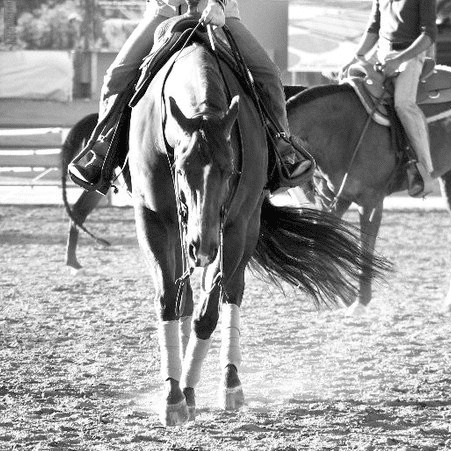The spin, or turnaround, has been a staple maneuver of horsemanship patterns since the invention of the class. To watch a well-executed pivot is comparable to a ballerina dancer performing a pirouette. However, what may seem like a common element in horsemanship and equitation is sometimes improperly carried out, often due to rider error. We spoke with AQHA/NSBA judge and two-time AQHA World Show Horsemanship winner, Nancy Renfro, about perfecting the spin.
Getting Technical with Technique
A proper horsemanship spin should demonstrate control, fluidity, and balance. Ideally, the horse should plant its inside hind foot and swivel around it like an axel. The front feet should land balanced on the ground flatly, while the horse lifts its shoulders and crosses the trailing front leg in front of the other with forward motion. Renfro accentuates that, “consistent movement in the turn is important.”
 Regarding this maneuver, Renfro (pictured right) is very particular about precision and management. She explains, “As a judge and a coach, I like to see an exhibitor demonstrate control of the turn. As an exhibitor starts the turn, I like to see that they are connected to their horse from their legs to their hands to the horse’s mouth.”
Regarding this maneuver, Renfro (pictured right) is very particular about precision and management. She explains, “As a judge and a coach, I like to see an exhibitor demonstrate control of the turn. As an exhibitor starts the turn, I like to see that they are connected to their horse from their legs to their hands to the horse’s mouth.”
She explains that a competent rider never waivers during the entire movement, “showing control as they start, execute and complete the turn. A turn that is correct and consistent is more credit-earning than the turn that is faster, out of position and that has a lack of connection. I also want to see that the rider controls and finishes the turn before proceeding into the next maneuver with fluency and connection to their horse.”
Build on What You Know
 Think control, balance, fluidity, and completion before adding speed. This is a good place for beginners and novices to start with regard to spins. Renfro discusses, “A novice’s focus should be on starting the pivot when the previous maneuver is complete. If you have to back up and then turn, make sure you have stopped after the back completely before asking for the turn.”
Think control, balance, fluidity, and completion before adding speed. This is a good place for beginners and novices to start with regard to spins. Renfro discusses, “A novice’s focus should be on starting the pivot when the previous maneuver is complete. If you have to back up and then turn, make sure you have stopped after the back completely before asking for the turn.”
This is necessary to maintain a forward motion in the turn and to be sure that the horse does not cross its front legs behind or step out of the turn with its hind feet, a common error made by beginners. Renfro continues, “Starting the turn correctly and having a consistent pace is also something novices should work on. Don’t keep asking to go faster in the turn until the maneuver is performed properly.
She also wants to see, “correct hand position in the turn. Like riding a bike, if you steer fast and hard, you will most likely crash. It is better to just guide with your hand when beginning.”
Renfro suggests that for any level of rider, “Forward side passing, walking or jogging tight circles, while eventually moving into the pivot,” are great exercises to perfect the spin.
Don’t Over-Do It
 Styles come and go, and as judges repetitively see spin after spin, they may develop a pet peeve for a variety of errors performed by exhibitors. Renfro is no exception, “Some of my pet peeves are when an exhibitor exaggerates their chin position during the turn. I often see riders turning their head sharply in the direction of the turn.”
Styles come and go, and as judges repetitively see spin after spin, they may develop a pet peeve for a variety of errors performed by exhibitors. Renfro is no exception, “Some of my pet peeves are when an exhibitor exaggerates their chin position during the turn. I often see riders turning their head sharply in the direction of the turn.”
Nancy suggests that head movement remain soft and natural and that a rider should slightly lead the direction of their turn with their eyes and a small motion of the head and neck that is natural to body position as one would guide themselves walking or driving a car. She also does not like to see when a rider, “does not allow (his/her) horse to stop and settle their feet before starting and leaving a turnaround.”
According to Renfro, the common trend of proceeding into the next maneuver almost before finishing the prior or later element has become outdated. Judges like to see a precise completion of each component before moving on. This will allow the horse and the rider to be in the correct position to continue the pattern and hopefully make for a more fluid, natural and balanced ride.
She also dislikes seeing an exhibitor, “drag their outside rein across the neck causing the horse’s nose to turn away from the direction of the turn.” This excessive neck-reining can cause the horse to become off balance and drop its shoulder into the turn. It may result in the horse throwing out its hip and thereby, move the pivot foot. There should be a strong connection with the leg and hand where the horse moves off the pressure of the rider’s leg, lifts its shoulder, sits on its pivot foot, and carries its rib-cage through the turn.”
In Summary
To reiterate, Renfro likes to see a rider finish each element before proceeding to the next. It shows a thought process from the exhibitor. They are demonstrating how to position themselves and their horse for the best execution. Also, the old mantra that ‘faster is better’ is completely outdated. The pivot should first of all be correct. Speed only adds to the level of difficulty, however, if it is not first correct, it is a hindrance to the balance of the pattern.
Lastly, Renfro adds that loose reins are obsolete in horsemanship. Judges want to see a rider who has light to moderate contact with their horse’s mouth. A clear connection between horse and rider helps present a picture of control and precision.
Photos © AQHA, Danielle Long, Carey Nowacek
About Our Contributor
Nancy Renfro has been showing Quarter Horses for 37 years. She has been an AQHA/NSBA judge for six years and has judged the AQHYA world show, All American Quarter Horse Congress, and NSBA World Show. She won her first AQHA World Championship in the Senior trail when she was only 16 years old. Outstandingly she has 13 AQHA World Championships and 26 All American Quarter Horse Congress wins. She has won the horsemanship twice at the AQHA World Show and five times at the Congress. She has also trained and coached World/Congress/NSBA Horsemanship Champions. Currently residing in Finley, California, Nancy enjoys family life, happily married to Thomas Renfro. They have to beautiful daughters, Madison and Meghan.










